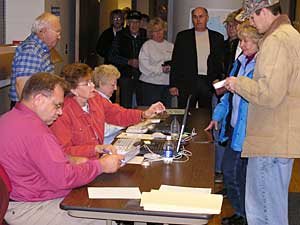Dakota residents turning out in record numbers to vote early
November 1, 2004
 |
| Cass county North Dakota had about 7,000 people vote in its absentee precinct four years ago. They expected a ten percent or fifteen percent increase. But today, they'll likely surpass 11,000 who chose to vote early in Fargo. (MPR Photo/Bob Reha) |
Fargo, N.D and Sioux Falls, S.D. — For the past two weeks, people in Cass county North Dakota have been voting. Under state law, county officials can open an early voting precinct.
The day before Election Day, voters are the Cass County courthouse are greeted by a volunteer and asked a few simple questions. Has your name or address changed since you voted last? If the answer is yes, people are directed to a volunteer to get the new information. Then, they join the line to vote.
Unlike absentee ballots, there is very little paper work involved to cast your vote early. That makes it an appealing process to voters. Cass county auditor Mike Montplaisir, expects 11,000 people will vote early.
"Actually, that's quite a bit higher than we expected," Montplaisir says. "We had about 7,000 people vote in our absentee precinct four years ago. And we kind of thought maybe a ten percent or fifteen percent increase so, we'll cross over 11,000, 11,500 people today."
 | |||
The ebb and flow of voters varies. Early this morning, the line is short and it doesn't take long to get a ballot and vote. Over the lunch hour things get busy and again around five o'clock business will pick up.
Early voting attracts a variety of people. First time voters, people leaving town and even, ex-governors. Former North Dakota Governor Ed Schaffer, says he's impressed with the system.
"This procedure worked pretty well," says Schaffer. "They were well organized, they checked the address, they pulled the ballot and hopefully it gets to the right place but it seemed to work just fine."
Making sure the votes are counted is a critical part of the process. In North Dakota, early voters place their ballots in a voting machine called a scanner. Auditor Mike Mountplaisir says the machine records the votes on what he calls a smart card. Montplaisir says the system is secure.
"When people put their ballot in there it's counted right away, but tapes aren't printed off until the polls are closed on election day," Montplaisir says. "Once we're done with early voting today, we'll take those cards out of those machines, we'll seal them up, the election board will sign the envelope it'll go into our vault. Then they'll come back at eight o'clock tomorrow night and take those cards out, put them in the machine and actually print the report."
240 miles down the road in Sioux Falls, South Dakota, the story is different. Minnehaha County Auditor, Sue Roust, is preparing for a long day of hard work counting all the absentee ballots they've received.
"We will have one scanner start right at seven o'clock, processing absentees," Rouse explains. "That one (scanner machine) will go all evening on absentees only and hopefully we'll make good headway that way."
In fact, Roust says her county had to purchase additional scanner machines from North Dakota to handle the 16,000 absentee votes already cast. Roust says that number is double the previous high. But she says that figure is small compared to the number of voters who will go to the polls on Tuesday.
"I told the workers you may have heard a lot about absentee voting," says Roust, "but that still leaves 80,000 people and most of them are going to come out and vote tomorrow."
Roust says every county in South Dakota is seeing record early voting numbers. That might be because of the tight U.S. Senate race between incumbent Democrat Tom Daschle and Republican challenger John Thune.
|
News Headlines
|
Related Subjects
|

